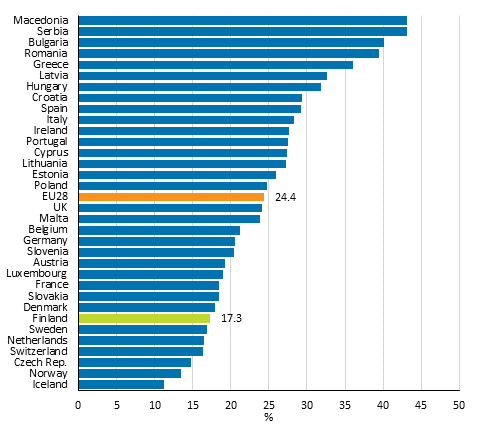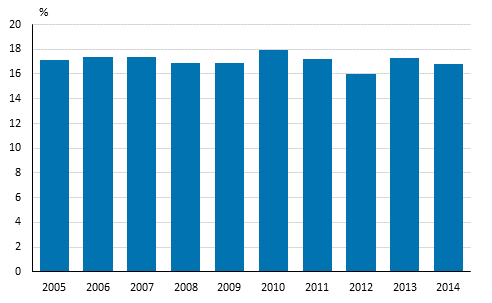Published: 25 May 2016
One-quarter of EU citizens are at risk of poverty or social exclusion
All in all, 24.4 per cent of the citizens of the European Union’s 28 member states were at risk of poverty or social exclusion. In Finland, 17.3 per cent of the household population were at risk of poverty or social exclusion, around 927,000 persons. These data derive from the results of the European Union Statistics on Income and Living Conditions, where Finland's data are based on Statistics Finland’s income distribution statistics.
Persons living at risk of poverty or social exclusion (AROPE) in Europe in 2013, %

Source: Eurostat, European statistics on income and living conditions (EU-SILC 2014, income reference year 2013, except for the United Kingdom 2014). Data are presented by income reference year but on the Eurostat website the corresponding data arefound by the year of data collection (income reference year + 1). Data extracted on 21st April 2016.
Most persons at risk of poverty or social exclusion in proportion to the population of the country were found in Serbia, Macedonia, Bulgaria and Romania, least in Iceland. Finland’s share is the fifth lowest among the EU countries. People at risk of poverty or social exclusion include low income earners, those who are materially deprived or living in a household with low work intensity. In a majority of countries, low income earners are most common. All in all, 17.3 per cent of the population in the EU Member States belonged to low income households in 2013. A that time, Finland’s rate of low income earners was the sixth lowest among the EU countries, 12.8 per cent. In six EU countries (Romania, Spain, Greece, Bulgaria, Estonia and Latvia), more than one-fifth of the population are low income earners.
For Finland, there are data available on persons at risk of poverty or social exclusion already from 2014. In all, 16.8 per cent of the population was at risk of poverty or social exclusion in 2014, that is 904,000 persons. So the share decreased slightly from the previous year. The share of persons at risk of poverty or social exclusion has varied in Finland between 16 and 17.9 per cent in 2005 to 2014. A majority of the share of persons at risk of poverty or social exclusion in Finland is explained with low income earners: on average, three out of four persons at risk of poverty or social exclusion are low income earners.
There is more variation in the share of persons at risk of poverty or social exclusion than, for example, in low income earners, which is one of the components of the risk indicator. Data on low income earners for 2014 have been published in the income distribution statistics on 18 March 2016 .
Share of persons at risk of poverty or social exclusion in Finland in 2005 to 2014

Source: Eurostat, European statistics on income and living conditions (EU-SILC 2014, income reference year 2013, except for the United Kingdom 2014). Data are presented by income reference year but on the Eurostat website the corresponding data arefound by the year of data collection (income reference year + 1). Data extracted on 21st April 2016.
The so-called AROPE indicator (At Risk of Poverty or Social Exclusion) that measures the risk of poverty or social exclusion is part of the monitoring of the objective of the Europe 2020 Strategy. Persons are classified as being at-risk-of-poverty when they live in a household, whose disposable monetary income per consumption unit is below 60 per cent of the national median income. Persons living in a household with low work intensity are all persons aged under 60, whose household's work input is below 20 per cent of the household's potential work input in the survey year. Potential work input refers to the combined theoretical working months of the household members aged between 18 and 59 (excl. non-independent young people aged between 18 and 24) per year. Persons, whose household suffers deprivation measured by at least four indicators out of nine are considered severely materially deprived. The indicators are experiencing payment difficulties, difficulty coping with unexpected financial expenses or that the household cannot afford a telephone, washing machine, television, car, protein-rich meal every other day, one week's holiday per year outside the home or keep their home warm enough.
Source: Income Distribution Statistics 2014, Statistics Finland
Inquiries: Kaisa-Mari Okkonen 029 551 3408, Veli-Matti Törmälehto 029 551 3680
Director in charge: Jari Tarkoma
- Tables
-
Tables in databases
Pick the data you need into tables, view the data as graphs, or download the data for your use.
Updated 25.5.2016
Official Statistics of Finland (OSF):
Income distribution statistics [e-publication].
ISSN=1799-1331. Income inequality (international comparison) 2014. Helsinki: Statistics Finland [referred: 25.12.2025].
Access method: http://stat.fi/til/tjt/2014/04/tjt_2014_04_2016-05-25_tie_001_en.html

